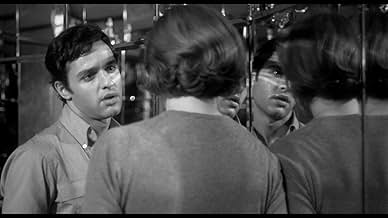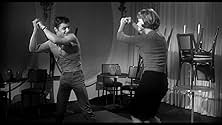In New York, a disco hostess is stalked by a sexual predator and she requests help from a vice squad detective who takes a personal interest in the case.In New York, a disco hostess is stalked by a sexual predator and she requests help from a vice squad detective who takes a personal interest in the case.In New York, a disco hostess is stalked by a sexual predator and she requests help from a vice squad detective who takes a personal interest in the case.
- Carlo
- (as Dan Travanty)
- Ms. Nielsen
- (as Casey Townsend)
- Black Man
- (uncredited)
Featured reviews
The highlight for me was in one of the final scenes where Sal Mineo and Juliet Prowse shimmy to one of the sassiest, silliest 60s dance tunes ever invented. Sal's wearing a little cut-off shirt and as he freaks out, more and more of his midriff is exposed. Sal's a long way from Rebel Without A Cause here, and looking all the better for it. This scene is worth the entrance fee alone. The title sequence is also hilariously evocative.
Full of weird characters, almost EVERYONE in this movie has a dirty little dark side waiting to be shown.
Yet this is a remarkable film, and much better than I'd anticipated (I'd never seen it before until recently). Shot in the winter of 1964/65, it's ahead of its time and covers subject matter taboo even now, certainly for mid-'60s Hollywood... It's B&W photography is as haunted and moody as a PSYCHO-era horror film, but TEDDY BEAR has an organic quality about it most Hollywood movies don't have today and didn't have yesterday --- and it reminds those of us old enough to remember of how the cities, from the mid-'60s to the '70s, were beginning to fall apart in the wake of JFK's death and the rise of the incomprehensible Vietnam war (where all our tax dollars were going) -- when peep shows and adult "book stores", with their wares on display in the shop windows, popped up in even "nice" business districts beside Tiffany's, creating a tense and fascinating shabbiness that helped define the schism that was "the '60s".
So the cultural meltdown wasn't just about the hippies and their drugs and the acid rock and the protests which would soon follow this movie (not that there was much of a reaction to the film itself, as few people saw it then); for all the romanticizing of that decade (some of which is understandable), Walter Cronkite wasn't entirely wrong when he called the 1960s "a slum of a decade" and TEDDY BEAR hints at that better than most industry films of the time, and serves to remind us that the world of that era wasn't really all that innocent (even if it was a bit naive in other ways). Such was that echo chamber, filled with its cacophony of voices, that was the '60s -- where you had two decades seemingly shoved into one. And with this movie squarely on the cusp of both.
Good acting, taut direction, and a lot of layers going on at one time...
The obscene phone call bits--all heavy breathing, bulging tighty whiteys and sweat--will make you want to leave the theatre and take a shower. Or, if that isn't nasty enough for you, how about the scene with bulldyke Elaine Stritch fondling Prowse's fur (so to speak), or the retarded kid sister locked in the closet or the policeman obsessively playing audio tapes of various twisted criminal's confessions as his daughter listens wide-eyed from the other side of the door? Or how about the "twist lesson" that brings the film to it's climax (no pun intended)? Another asset of this great piece of cinema are its New York City location shots, especially when Mineo goes walking the city at night, looking for filth in scenes that must've influenced "Taxi Driver" (also love the W.S. Burroughs titles in the window of the "dirty bookshop"). I cannot recommend this movie highly enough. It's not available on video (Curses!), so if it's ever screened at the theater or on TV in your area, be there.
By 1965, the barriers were starting to be breached in what could be shown, or even implied, on the screen (Who's Afraid of Virginia Woolf dates from that year). But Who Killed Teddy Bear rubs, brusquely and suggestively, against just about every taboo obtaining then or now. It's a New York story, but of the grotty 1960s, when Manhattan led the nation as an example of how American cities were surrendering to crime and vice and ugliness at the core.
Spinning platters in a seedy discotheque, Juliet Prowse starts getting obscene phone calls then finds a decapitated teddy bear in her apartment. Police detective Jan Murray takes the case, which holds an obsessive interest for him. Four years earlier his wife had been raped and murdered; now the world of perversion and fetishism has become his life, both professionally and privately (despite a young daughter, who listens to him listening to his lurid tapes from her bedroom). Prowse becomes so shaken by the stalking that she can't quite trust him, or for that matter her tough-as-nails boss Elaine Stritch, who, invited home to serve as protection, makes a pass at her. Shown the door, Stritch, in a slip and fur coat, wanders the dark streets and back alleys, where....
Top billing goes to Sal Mineo, 10 years after his debut as Plato in Rebel Without A Cause, as a waiter in the club. Back home he has a child-like grown sister, whom he locks in the closet when he's making the rounds of the porn shops and peep shows near Times Square. Though his character isn't gay, he's served up like prime, pre-Stonewall beefcake, halfway between raw and blue; towards the end, when Prowse teaches him to dance, he erupts like a go-go boy.
The movie bears all the marks of a starvation budget, but for once the saturated photography and jumpy cutting seem just right. The odd but savvy cast even the young Daniel J. `Travanty' makes his debut as a deaf-mute bouncer brings from Broadway and east-coast television a rough edge that's far from Hollywood's buffed and smooth product. But it's the vision of the TV-reared director, Joseph Cates, and writers Arnold Drake and Leon Tokatyan that makes Who Killed Teddy Bear so hard to shake. Neither a tidy thriller nor a nuanced character study, it nonetheless has a trump card to play: It's the real McCoy,a genuine creepshow.
Did you know
- TriviaThe print released on home video by Network is missing a few minutes of sleaze content. The original theatrical version has images of pornographic books and magazines, as well as explicit lobby cards displayed by a Times Square adult movie theater.
- GoofsDuring the first scene set at the discotheque, Juliet Prowse puts on a new record after we see the crowd dancing to the first song. However, minutes later, we see the crowd dancing to the first song again.
- Quotes
Lt. Dave Madden: Some are fetishists, some are sadists, some are masochists, then there are the simple voyeurs, the pediophiliacs, but even that's too neat, too much like rules. So we have the combinations. And I'm not talking about your uncle Charlie, who buys pin-up calendars, I mean the complicated pairing. The sado-masochist, the voyeur-masochist, the exhibitionists, the necrophiliacs.
Norah Dain: You seem to know a lot about these things.
Lt. Dave Madden: Someone should.
- Alternate versions3 minutes of the film were cut following premiere showings, resulting in a 91-minute version which deletes some scenes of Sal Mineo working out and swimming at the gym where he encounters Juliet Prowse. The 2024 4K restoration of the film restores this material.
- ConnectionsFeatured in Peter Berlin (2005)
- SoundtracksWho Killed Teddy Bear?
(uncredited)
Written by Bob Gaudio and Al Kasha
Sung by Rita Dyson
[Played over both the opening title and credits, and end title card]
- How long is Who Killed Teddy Bear?Powered by Alexa
Details
- Release date
- Country of origin
- Languages
- Also known as
- Qui a tué l'ours en peluche
- Filming locations
- Manhattan, New York City, New York, USA(Times Square)
- Production company
- See more company credits at IMDbPro
- Runtime1 hour 34 minutes
- Color
- Sound mix
- Aspect ratio
- 1.85 : 1
Contribute to this page




























